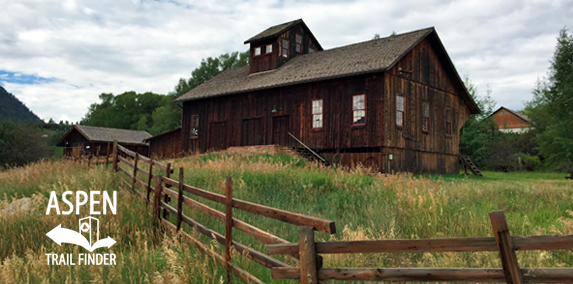Connects: Bergman Trail, Marolt Trail

The Holden/Marolt Mining and Ranching Museum along the Marolt Trail
Aspen, CO – Historic
The Holden/Marolt Mining and Ranching Museum is a historic site where the Holden Mining and Smelting Co. once was. The Holden Mining and Smelting Co. is listed on the National Register of Historic Places. This is a historic site that was once a state-of-the-art silver processing plant known as the Holden Lixivation Works in Aspen, CO.
More information about the Holden/Marolt Mining and Ranching Museum can be found at:
National Register of Historic Places – Holden Mining and Smelting Co.
Aspen Historical Society – Holden/Marolt Mining and Ranching Museum
Wikipedia – Holden/Marolt Mining and Ranching Museum
In 1981, the Holden Lixiviation Mill sprawled over 22 acres at the edge of Aspen, boasting state-of-the-art technology and industrial design. Just 14 months after the new plant opened, Congress demonetized silver and the mill went bankrupt. Mike Marolt purchased the property for one dollar in 1940 as part of the family ranch. Holden/Marolt tells the stories of both Aspen’s mining and ranching heritage.
Founded as a silver mining camp in 1879, by 1890 Aspen had a population of over 12,000 and was the single largest silver producer in the US.
Aspen’s big news in 1892 was the building of the holden Lixiviation works on the west side of town. The newspaper declared that “the sweet day dreams of those who have longed to see Aspen a great city are about to be realized.” Completed just 14 months before congress repealed the Sherman Silver Act, the plant never cleared a profit and went bankrupt almost immediately. It was one of only eighteen plants build world-wide to utilize the experimental Russell Lixiviation process to refine low grade ore.
The Russell Lixiviation process used crushing, heat, and chemical salts to refine silver from ore as low grade as ten ounces per ton (Aspen ores averaged 400 to 600 ounces of silver per ton, but much low grade ore had to be discarded). The fumes from the plant’s Stetefeldt furnaces were emitted from the main smoke stake 165 feet high, reputed to be the highest stack in the state. One reason the Sampling building still stands today is because it was built to hold large machinery that crushed and pulverized ore.
By 1904, after several attempts to run the Holden Works as a concentrator (a process of discarding some of the worthless material to make the low grade ore cheaper to transport), the plant was closed. During the quiet years the Marolt family ranched near the mill. In 1940 Mike Marolt purchased the mill for one dollar and combined it with the Midland Ranch to form the Marolt Ranch. The Marolts raised sheep and cattle and planted potatoes. By the late 1950’s, the Marolts started selling off parcels of their land, due to decreasing Forest Service grazing acreage, financial strains of the kids’ college educations, and Mike Marolt’s deteriorating health.
This site, once a symbol of Aspen’s industrial might, became the symbol of a vanishing ranching economy as skiing fueled the rebuilding of Aspen. For more information visit www.aspenhistory.org.”

























